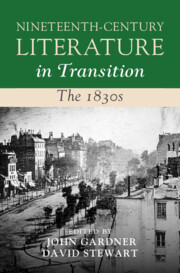Book contents
- Nineteenth-Century Literature in Transition: The 1830s
- Nineteenth-Century Literature in Transition
- Nineteenth-Century Literature in Transition: The 1830s
- Copyright page
- Contents
- Figures
- Contributors
- Acknowledgements
- Introduction
- Chapter 1 On the Eve
- Chapter 2 ‘An Infectious Madness’
- Chapter 3 Augustus Hardin Beaumont, Slavery Apologias, and Popular Radical Literature in the 1830s
- Chapter 4 Patterns of Industry
- Chapter 5 Mother Earth
- Chapter 6 The Polite Fictions of Slavery
- Chapter 7 Suffering, Sentiment, and the Rise of Humanitarian Literature in the 1830s
- Chapter 8 Steam and Iron in the 1830s
- Chapter 9 Lithography and the Comic Image 1825–1840
- Chapter 10 Jorrocks’s Canon
- Chapter 11 Tennyson, Dickens, Poe, Browning, and the Brontës:Blackwood’s Magazine and ‘The Foreheads of a New Generation’
- Chapter 12 Boz in London: The 1830s and the Urban Turn in the English Novel
- Chapter 13 Letitia Elizabeth Landon, Chronicler of the 1830s
- Chapter 14 Railway Imaginary in the 1830s
- Chapter 15 The Emerging Language of Photography
- Afterword
- Index
Chapter 15 - The Emerging Language of Photography
Published online by Cambridge University Press: 30 May 2024
- Nineteenth-Century Literature in Transition: The 1830s
- Nineteenth-Century Literature in Transition
- Nineteenth-Century Literature in Transition: The 1830s
- Copyright page
- Contents
- Figures
- Contributors
- Acknowledgements
- Introduction
- Chapter 1 On the Eve
- Chapter 2 ‘An Infectious Madness’
- Chapter 3 Augustus Hardin Beaumont, Slavery Apologias, and Popular Radical Literature in the 1830s
- Chapter 4 Patterns of Industry
- Chapter 5 Mother Earth
- Chapter 6 The Polite Fictions of Slavery
- Chapter 7 Suffering, Sentiment, and the Rise of Humanitarian Literature in the 1830s
- Chapter 8 Steam and Iron in the 1830s
- Chapter 9 Lithography and the Comic Image 1825–1840
- Chapter 10 Jorrocks’s Canon
- Chapter 11 Tennyson, Dickens, Poe, Browning, and the Brontës:Blackwood’s Magazine and ‘The Foreheads of a New Generation’
- Chapter 12 Boz in London: The 1830s and the Urban Turn in the English Novel
- Chapter 13 Letitia Elizabeth Landon, Chronicler of the 1830s
- Chapter 14 Railway Imaginary in the 1830s
- Chapter 15 The Emerging Language of Photography
- Afterword
- Index
Summary
The 7th of January 1839, the day on which Daguerre’s invention was announced to the public, is just one mark on photography’s long evolutionary calendar. Daguerre and Henry Talbot had succeeded in producing images years earlier using entirely different processes, although, for most of the 1830s, few people had seen them. Plenty, however, had heard about them: words inevitably preceded images. This chapter focusses on letters and other writings in which the concept of photography was taking shape in the decade before photography officially began, and it considers the wider public discourse in which such writing participated. It proposes that photography’s private pre-history reflects epistemological developments and anticipates literary and cultural shifts. While it focusses on English-language letters and draws primarily from Talbot’s correspondence, it also makes use of translated commentaries from periodicals and papers, departing from the tidy conventional narrative of invention and history to consider instead a messier ongoing conversation about something humans very much wanted: something that, throughout the 1830s, didn’t yet answer to the name of photography.
- Type
- Chapter
- Information
- Nineteenth-Century Literature in Transition: The 1830s , pp. 319 - 340Publisher: Cambridge University PressPrint publication year: 2024

